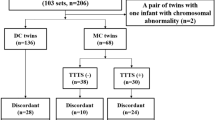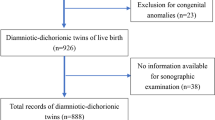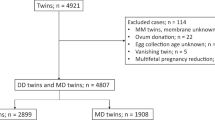Abstract
Objective
Through a systematic review and meta-analyses, we aimed to analyze the impact of chorionicity on neurodevelopment outcomes.
Study design
We conducted a comprehensive search strategy through Medline, Embase, Web of Science, and reference lists of the retrieved studies until August 2022. Studies that examined the association between chorionicity and children’s neurodevelopment outcomes were included.
Results
Twelve studies were included. Monochorionic (MC) twins increased the odds of neurodevelopment impairment, cerebral palsy compared to dichorionic (DC) twins. The differences in neurodevelopmental impairment and cerebral palsy between the two groups disappeared after excluding infants with twin-twin transfusion (TTTS). After fetoscopic laser surgery (FLS) for MC twins, there were no differences too.
Conclusions
Compared to DC twins, MC twins were associated with an increased risk of neurodevelopment impairment. MC twins complicated by TTTS were at high risk of neurologic disability, and FLS was an acceptable treatment modality for them.
This is a preview of subscription content, access via your institution
Access options
Subscribe to this journal
Receive 12 print issues and online access
$259.00 per year
only $21.58 per issue
Buy this article
- Purchase on Springer Link
- Instant access to full article PDF
Prices may be subject to local taxes which are calculated during checkout






Similar content being viewed by others
Data availability
Correspondence and requests for materials should be addressed to FZ.
References
Lopriore E, Lewi L, Khalil A. Monochorionic twins: a delicate balance. J Clin Med. 2019;8:1711.
Lugthart MA, Horenblas J, Kleinrouweler EC, Engels M, Knegt AC, Huijsdens K, et al. Prenatal sonographic features can accurately determine parental origin in triploid pregnancies. Prenat Diagn. 2020;40:705–14.
Jha P, Morgan TA, Kennedy A. US evaluation of twin pregnancies: importance of chorionicity and amnionicity. Radiographics 2019;39:2146–66.
Feng B, Zhai J, Cai Y. Effect of twin pregnancy chorionic properties on maternal and fetal outcomes. Taiwan J Obstet Gynecol. 2018;57:351–4.
Di Mascio D, Acharya G, Khalil A, Odibo A, Prefumo F, Liberati M, et al. Birthweight discordance and neonatal morbidity in twin pregnancies: a systematic review and meta-analysis. Acta Obstet Gynecol Scand. 2019;98:1245–57.
Kosinska-Kaczynska K, Szymusik I, Bomba-Opon D, Olejek A, Slawska H, Zimmer M, et al. Perinatal outcome according to chorionicity in twins - a Polish multicenter study. Ginekol Pol. 2016;87:384–9.
Homola W, Florjanski J, Krolak-Olejnik B, Fuchs T, Lachowska M, Bek W. The impact of chorionicity and the type of twin growth on the early neonatal outcome in twin pregnancies − 20 years of experience from one tertiary perinatal center. Taiwan J Obstet Gynecol. 2019;58:482–6.
Park YH, Kim YN, Im DH, Kim DH, Byun JM, Jeong DH, et al. Neonatal outcomes between discordant monochorionic and dichorionic twins. J Matern Fetal Neonatal Med. 2021;34:2080–8.
Rajagopalan V, Ashouri K, Llanes A, Vanderbilt DL, Lepore N, Bluml S, et al. Fetal neurodevelopmental recovery in donors after laser surgery for twin-twin transfusion syndrome. Prenat Diagn. 2021;41:190–9.
Garcia-Garcia S, Kakaizada S, Oleaga L, Benet A, Rincon-Toroella J, Gonzalez-Sanchez JJ. Presurgical simulation for neuroendoscopic procedures: virtual study of the integrity of neurological pathways using diffusion tensor imaging tractography. Neurol India. 2019;67:763–9.
Deopujari C, Shaikh S. Presurgical simulation for neuroendoscopic procedures to virtually study the integrity of neurological pathways using diffusion tensor imaging tractography. Neurol India. 2019;67:770–1.
Tober C, Schoop R. Modulation of neurological pathways by Salvia officinalis and its dependence on manufacturing process and plant parts used. BMC Complement Alter Med. 2019;19:128.
Owen MJ, O’Donovan MC. Schizophrenia and the neurodevelopmental continuum: evidence from genomics. World Psychiatry. 2017;16:227–35.
Halling C, Malone FD, Breathnach FM, Stewart MC, Mcauliffe FM, Morrison JJ, et al. Neuro-developmental outcome of a large cohort of growth discordant twins. Eur J Pediatr. 2016;175:381–9.
Christensen R, Chau V, Synnes A, Grunau RE, Miller SP. Longitudinal neurodevelopmental outcomes in preterm twins. Pediatr Res. 2021;90:593–9.
Hack KE, Koopman-Esseboom C, Derks JB, Elias SG, de Kleine MJ, Baerts W, et al. Long-term neurodevelopmental outcome of monochorionic and matched dichorionic twins. Plos One. 2009;4:e6815.
Ichinomiya K, Maruyama K, Koizumi A, Inoue F, Fukuda K, Kaburagi K, et al. Comparison of neurodevelopmental outcomes between monochorionic and dichorionic twins with birth weight ≤ 1500 g in Japan: a register-based cohort study. J Perinatol. 2018;38:1407–13.
Ruegg L, Husler M, Krahenmann F, Zimmermann R, Natalucci G, Ochsenbein-Kolble N. Long-term outcome of monochorionic twins after fetoscopic laser therapy compared to matched dichorionic twins. Fetal Diagn Ther. 2020;47:947–54.
Sommer J, Nuyt AM, Audibert F, Dorval V, Wavrant S, Altit G, et al. Outcomes of extremely premature infants with twin-twin transfusion syndrome treated by laser therapy. J Perinatol. 2018;38:1548–55.
Khalil A, Rodgers M, Baschat A, Bhide A, Gratacos E, Hecher K, et al. ISUOG Practice Guidelines: role of ultrasound in twin pregnancy. Ultrasound Obstet Gynecol. 2016;47:247–63.
Rosenbaum P, Paneth N, Leviton A, Goldstein M, Bax M, Damiano D, et al. A report: the definition and classification of cerebral palsy April 2006. Dev Med Child Neurol Suppl. 2007;109:8–14.
Tricco AC, Lillie E, Zarin W, O’Brien KK, Colquhoun H, Levac D, et al. PRISMA Extension for Scoping Reviews (PRISMA-ScR): checklist and explanation. Ann Intern Med. 2018;169:467–73.
Di Toro F, Gjoka M, Di Lorenzo G, De Santo D, De Seta F, Maso G, et al. Impact of COVID-19 on maternal and neonatal outcomes: a systematic review and meta-analysis. Clin Microbiol Infect. 2021;27:36–46.
Bolch C, Fahey M, Reddihough D, Williams K, Reid S, Guzys A, et al. Twin-to-twin transfusion syndrome neurodevelopmental follow-up study (neurodevelopmental outcomes for children whose twin-to-twin transfusion syndrome was treated with placental laser photocoagulation). BMC Pediatr. 2018;18:256.
Gajawelli N, Deoni S, Shi J, Linguraru MG, Porras AR, Nelson MD, et al. Neurocranium thickness mapping in early childhood. Sci Rep. 2020;10:16651.
Osterman M, Hamilton B, Martin JA, Driscoll AK, Valenzuela CP. Births: final data for 2020. Natl Vital- Stat Rep. 2021;70:1–50.
Norris JM, Simpson BS, Ball R, Freeman A, Kirkham A, Parry MA, et al. A modified Newcastle-Ottawa Scale for assessment of study quality in genetic urological research. Eur Urol. 2021;79:325–6.
Tosello B, Garbi A, Blanc J, Lorthe E, Foix L, Hélias L, et al. The impact of chorionicity on pregnancy outcome and neurodevelopment at 2 years old among twins born preterm: the EPIPAGE‐2 cohort study. BJOG. 2021;128:281–91.
Kawamura H, Ishii K, Yonetani N, Mabuchi A, Hayashi S, Mitsuda N. Significance of chorionicity on long-term outcome of low birthweight infants of <1500g in twin pregnancies. J Obstet Gynaecol Re. 2015;41:1185–92.
Adegbite AL, Castille S, Ward S, Bajoria R. Neuromorbidity in preterm twins in relation to chorionicity and discordant birth weight. Am J Obstet Gynecol. 2004;190:156–63.
Asztalos EV, Barrett JFR, Lacy M, Luther M. Evaluating 2 year outcome in twins ≤ 30 weeks gestation at birth: a regional perinatal unit’s experience. Twin Res. 2001;4:431–8.
Minakami H, Honma Y, Matsubara S, Uchida A, Shiraishi H, Sato I. Effects of placental chorionicity on outcome in twin pregnancies. A cohort study. J Reprod Med. 1999;44:595–600.
Taborda A, Oliveira G. Neurodevelopmental outcomes of very preterm or very low birth weigth infants: comparison of monochorionic and dichorionic twins with singletons. Acta Med Port. 2016;29:702–10.
Nelson KB, Ellenberg JH. Childhood neurological disorders in twins. Paediatr Perinat Ep. 1995;9:135–45.
Lenclen R, Ciarlo G, Paupe A, Bussieres L, Ville Y. Neurodevelopmental outcome at 2 years in children born preterm treated by amnioreduction or fetoscopic laser surgery for twin-to-twin transfusion syndrome: comparison with dichorionic twins. Am J Obstet Gynecol. 2009;201:291.
Aoki S, Hashimoto K, Ikeda N, Takekoh M, Fujiwara T, Morisaki N, et al. Comparison of the Kyoto Scale of Psychological Development 2001 with the parent-rated Kinder Infant Development Scale (KIDS). Brain Dev. 2016;38:481–90.
Gould JF, Hunt E, Roberts RM, Louise J, Collins CT, Makrides M. Can the Bayley Scales of Infant Development at 18 months predict child behaviour at 7 years? J Paediatr Child Health. 2019;55:74-81.
Wang H, Du Y, Mao Z, Che Y, Li H, Ding L, et al. Use of the Griffiths mental development scale-Chinese in the assessment of children with autism spectrum disorder and global developmental delay/intellectual disability. Med (Baltim). 2021;100:e25407.
Castro S, Coelho V, Pinto A. Identification of functional domains in developmental measures: an ICF-CY analysis of Griffiths developmental scales and Schedule of Growing Skills II. Dev Neurorehabil. 2016;19:231–7.
Schonhaut L, Martinez-Nadal S, Armijo I, Demestre X. Reliability and agreement of ages and stages questionnaires(R): results in late preterm and term-born infants at 24 and 48months. Early Hum Dev. 2019;128:55–61.
Marceau K, Mcmaster MT, Smith TF, Daams JG, van Beijsterveldt CE, Boomsma DI, et al. The prenatal environment in twin studies: a review on chorionicity. Behav Genet. 2016;46:286–303.
Lucas A, Morley R, Cole TJ. Randomised trial of early diet in preterm babies and later intelligence quotient. BMJ 1998;317:1481–7.
Edmonds CJ, Isaacs EB, Cole TJ, Rogers MH, Lanigan J, Singhal A, et al. The effect of intrauterine growth on verbal IQ scores in childhood: a study of monozygotic twins. Pediatrics 2010;126:e1095–e1101.
Campos D, Arias AV, Campos-Zanelli TM, Souza DS, Dos SNO, Peralta CF, et al. Twin-twin transfusion syndrome: neurodevelopment of infants treated with laser surgery. Arq Neuropsiquiatr. 2016;74:307–13.
Brandsma FL, Spruijt MS, Rijken M, Tan R, Oepkes D, Lopriore E, et al. Behavioural outcome in twin-twin transfusion syndrome survivors treated with laser surgery. Arch Dis Child Fetal Neonatal Ed. 2020;105:304–9.
Aita M, De Clifford FG, Lavallee A, Feeley N, Stremler R, Rioux E, et al. Effectiveness of interventions on early neurodevelopment of preterm infants: a systematic review and meta-analysis. BMC Pediatr. 2021;21:210.
Collins RN, Lyle RE, Rettiganti M, Gossett JM, Robbins JM, Casey PH. Long-term neurodevelopment of low-birthweight, preterm infants with patent ductus arteriosus. J Pediatr. 2018;203:170–6.
Yu F, Mak A, Chan NM, Siu KL, Ma T, Leung KY. Prospective risk of stillbirth and neonatal complications for monochorionic diamniotic and dichorionic diamniotic twins after 24 weeks of gestation. J Obstet Gynaecol Res. 2021;47:3127–35.
Siqueiros SM, Falck-Ytter T, Kennedy DP, Bolte S, Lichtenstein P, D’Onofrio BM, et al. Volitional eye movement control and ADHD traits: a twin study. J Child Psychol Psychiatry. 2020;61:1309–16.
Glanc P, Nyberg DA, Khati NJ, Deshmukh SP, Dudiak KM, Henrichsen TL, et al. ACR Appropriateness Criteria((R)) Multiple Gestations. J Am Coll Radio. 2017;14:S476–S489.
Goel D, Luig M, Maheshwari R, D’Cruz D, Goyen TA. General movement assessment and neurodevelopmental trajectory in extremely preterm infants with hypothyroxinaemia of prematurity (THOP). Early Hum Dev. 2020;144:104886.
Funding
This work was supported by the Funding of Science and Technology Program of Nantong City under Grant [MS12020036] and under Grant [MS12021040].
Author information
Authors and Affiliations
Contributions
SHY designed the study, conducted literature searches, study selections, and data extractions, and drafted the initial manuscript. YW and ZFC conducted literature searches, study selections, and data extractions. FZ reviewed and revised the manuscript. All authors have approved the final manuscript and agreed to be accountable for all aspects of the work.
Corresponding author
Ethics declarations
Competing interests
The authors declare no competing interests.
Additional information
Publisher’s note Springer Nature remains neutral with regard to jurisdictional claims in published maps and institutional affiliations.
Supplementary information
Rights and permissions
Springer Nature or its licensor holds exclusive rights to this article under a publishing agreement with the author(s) or other rightsholder(s); author self-archiving of the accepted manuscript version of this article is solely governed by the terms of such publishing agreement and applicable law.
About this article
Cite this article
Yan, S., Wang, Y., Chen, Z. et al. Chorionicity and neurodevelopmental outcomes in twin pregnancy: a systematic review and meta-analysis. J Perinatol 43, 133–146 (2023). https://doi.org/10.1038/s41372-022-01534-y
Received:
Revised:
Accepted:
Published:
Issue Date:
DOI: https://doi.org/10.1038/s41372-022-01534-y



